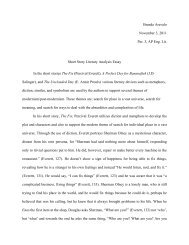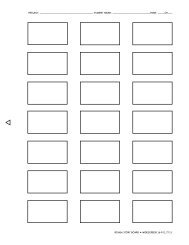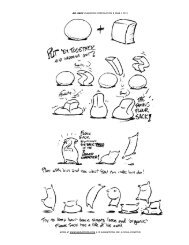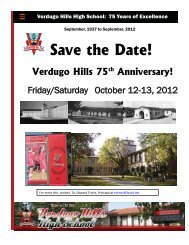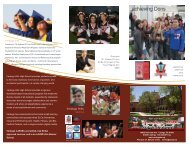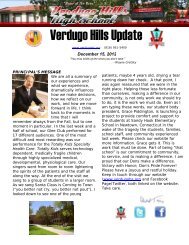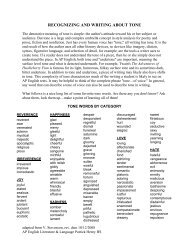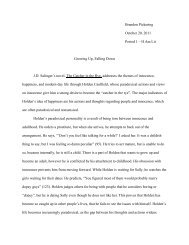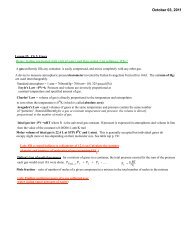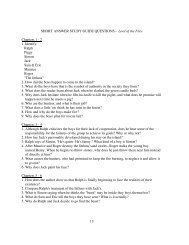REV Glossary of Poetry Terms - Verdugo Hills High School
REV Glossary of Poetry Terms - Verdugo Hills High School
REV Glossary of Poetry Terms - Verdugo Hills High School
- No tags were found...
Create successful ePaper yourself
Turn your PDF publications into a flip-book with our unique Google optimized e-Paper software.
<strong>Glossary</strong> <strong>of</strong> <strong>Poetry</strong> <strong>Terms</strong>AP English Literature/ Mr. Mendelsohn/ <strong>Verdugo</strong> <strong>Hills</strong> Multimedia Magnet <strong>High</strong> <strong>School</strong>accentThe prominence or emphasis given to a syllable or word. In the word poetry, the accent (or stress) falls onthe first syllable.alexandrineA line <strong>of</strong> poetry that has 12 syllables. The name probably comes from a medieval romance aboutAlexander the Great that was written in 12-syllable lines.alliterationThe repetition <strong>of</strong> the same or similar sounds at the beginning <strong>of</strong> words: “What would the world be, oncebereft/Of wet and wildness?” (Gerard Manley Hopkins, “Inversnaid”)anapestA metrical foot <strong>of</strong> three syllables, two short (or unstressed) followed by one long (or stressed), as inseventeen and to the moon. The anapest is the reverse <strong>of</strong> the dactyl.antithesisA figure <strong>of</strong> speech in which words and phrases with opposite meanings are balanced against each other.An example <strong>of</strong> antithesis is “To err is human, to forgive, divine.” (Alexander Pope)apostropheWords that are spoken to a person who is absent or imaginary, or to an object or abstract idea. The poemGod's World by Edna St. Vincent Millay begins with an apostrophe: “O World, I cannot hold thee closeenough!/Thy winds, thy wide grey skies!/Thy mists that roll and rise!”assonanceThe repetition or a pattern <strong>of</strong> similar sounds, especially vowel sounds: “Thou still unravished bride <strong>of</strong>quietness,/Thou foster child <strong>of</strong> silence and slow time” (“Ode to a Grecian Urn,” John Keats).balladA poem that tells a story similar to a folk tale or legend and <strong>of</strong>ten has a repeated refrain. “The Rime <strong>of</strong> theAncient Mariner” by Samuel Taylor Coleridge is an example <strong>of</strong> a ballad.balladeA type <strong>of</strong> poem, usually with three stanzas <strong>of</strong> seven, eight, or ten lines and a shorter final stanza (orenvoy) <strong>of</strong> four or five lines. All stanzas end with the same one-line refrain.blank verse<strong>Poetry</strong> that is written in unrhymed iambic pentameter. Shakespeare wrote most <strong>of</strong> his plays in blankverse.caesuraA natural pause or break in a line <strong>of</strong> poetry, usually near the middle <strong>of</strong> the line. There is a caesura rightafter the question mark in the first line <strong>of</strong> this sonnet by Elizabeth Barrett Browning: “How do I love thee?Let me count the ways.”canzoneA medieval Italian lyric poem, with five or six stanzas and a shorter concluding stanza (or envoy). Thepoets Petrarch and Dante Alighieri were masters <strong>of</strong> the canzone.carpe diemA Latin expression that means “seize the day.” Carpe diem poems urge the reader (or the person to whomthey are addressed) to live for today and enjoy the pleasures <strong>of</strong> the moment. A famous carpe diem poemby Robert Herrick begins “Gather ye rosebuds while ye may…”classicismThe principles and ideals <strong>of</strong> beauty that are characteristic <strong>of</strong> Greek and Roman art, architecture, andliterature. Examples <strong>of</strong> classicism in poetry can be found in the works <strong>of</strong> John Dryden and AlexanderPope, which are characterized by their formality, simplicity, and emotional restraint.
conceitA fanciful poetic image or metaphor that likens one thing to something else that is seemingly verydifferent. An example <strong>of</strong> a conceit can be found in Shakespeare's sonnet “Shall I compare thee to asummer's day?” and in Emily Dickinson's poem “There is no frigate like a book.”consonanceThe repetition <strong>of</strong> similar consonant sounds, especially at the ends <strong>of</strong> words, as in lost and past or confessand dismiss.coupletIn a poem, a pair <strong>of</strong> lines that are the same length and usually rhyme and form a complete thought.Shakespearean sonnets usually end in a couplet.dactylA metrical foot <strong>of</strong> three syllables, one long (or stressed) followed by two short (or unstressed), as inhappily. The dactyl is the reverse <strong>of</strong> the anapest.elegyA poem that laments the death <strong>of</strong> a person, or one that is simply sad and thoughtful. An example <strong>of</strong> thistype <strong>of</strong> poem is Thomas Gray's “Elegy Written in a Country Churchyard.”enjambmentThe continuation <strong>of</strong> a complete idea (a sentence or clause) from one line or couplet <strong>of</strong> a poem to the nextline or couplet without a pause. An example <strong>of</strong> enjambment can be found in the first line <strong>of</strong> JoyceKilmer's poem Trees: “I think that I shall never see/A poem as lovely as a tree.” Enjambment comesfrom the French word for “to straddle.”epicA long, serious poem that tells the story <strong>of</strong> a heroic figure. Two <strong>of</strong> the most famous epic poems are theIliad and the Odyssey by Homer, which tell about the Trojan War and the adventures <strong>of</strong> Odysseus on hisvoyage home after the war.epigramA very short, witty poem: “Sir, I admit your general rule,/That every poet is a fool,/But you yourself mayserve to show it,/That every fool is not a poet.” (Samuel Taylor Coleridge)epithalamium (or epithalamion)A poem in honor <strong>of</strong> a bride and bridegroom.feminine rhymeA rhyme that occurs in a final unstressed syllable: pleasure/leisure, longing/yearning.figure <strong>of</strong> speechA verbal expression in which words or sounds are arranged in a particular way to achieve a particulareffect. Figures <strong>of</strong> speech are organized into different categories, such as alliteration, assonance, metaphor,metonymy, onomatopoeia, simile, and synecdoche.footTwo or more syllables that together make up the smallest unit <strong>of</strong> rhythm in a poem. For example, an iambis a foot that has two syllables, one unstressed followed by one stressed. An anapest has three syllables,two unstressed followed by one stressed.free verse (also vers libre)<strong>Poetry</strong> composed <strong>of</strong> either rhymed or unrhymed lines that have no set meter.haikuA Japanese poem composed <strong>of</strong> three unrhymed lines <strong>of</strong> five, seven, and five syllables. Haiku <strong>of</strong>ten reflecton some aspect <strong>of</strong> nature.heptameterA line <strong>of</strong> poetry that has seven metrical feet.heroic coupletA stanza composed <strong>of</strong> two rhymed lines in iambic pentameter.hexameterA line <strong>of</strong> poetry that has six metrical feet.
hyperboleA figure <strong>of</strong> speech in which deliberate exaggeration is used for emphasis. Many everyday expressions areexamples <strong>of</strong> hyperbole: tons <strong>of</strong> money, waiting for ages, a flood <strong>of</strong> tears, etc. Hyperbole is the opposite <strong>of</strong>litotes.iambA metrical foot <strong>of</strong> two syllables, one short (or unstressed) and one long (or stressed). There are four iambsin the line “Come live/ with me/ and be/ my love,” from a poem by Christopher Marlowe. (The stressedsyllables are in bold.) The iamb is the reverse <strong>of</strong> the trochee.iambic pentameterA type <strong>of</strong> meter in poetry, in which there are five iambs to a line. (The prefix penta- means “five,” as inpentagon, a geometrical figure with five sides. Meter refers to rhythmic units. In a line <strong>of</strong> iambicpentameter, there are five rhythmic units that are iambs.) Shakespeare's plays were written mostly iniambic pentameter, which is the most common type <strong>of</strong> meter in English poetry. An example <strong>of</strong> an iambicpentameter line from Shakespeare's Romeo and Juliet is “But s<strong>of</strong>t!/ What light/ through yon/der win/dowbreaks?” Another, from Richard III, is “A horse!/ A horse!/ My king/dom for/ a horse!” (The stressedsyllables are in bold.)idyll, or idylEither a short poem depicting a peaceful, idealized country scene, or a long poem that tells a story aboutheroic deeds or extraordinary events set in the distant past. “Idylls <strong>of</strong> the King”, by Alfred LordTennyson, is about King Arthur and the Knights <strong>of</strong> the Round Table.limerickA light, humorous poem <strong>of</strong> five usually anapestic lines with the rhyme scheme <strong>of</strong> A-A-B-B-AlitotesA figure <strong>of</strong> speech in which a positive is stated by negating its opposite. Some examples <strong>of</strong> litotes: nosmall victory, not a bad idea, not unhappy. Litotes is the opposite <strong>of</strong> hyperbole.lyricA poem, such as a sonnet or an ode that expresses the thoughts and feelings <strong>of</strong> the poet. A lyric poemmay resemble a song in form or style.metaphorA figure <strong>of</strong> speech in which two things are compared, usually by saying one thing is another, or bysubstituting a more descriptive word for the more common or usual word that would be expected. Someexamples <strong>of</strong> metaphors: the world's a stage, he was a lion in battle, drowning in debt, and a sea <strong>of</strong>troubles.meterThe arrangement <strong>of</strong> a line <strong>of</strong> poetry by the number <strong>of</strong> syllables and the rhythm <strong>of</strong> accented (or stressed)syllables.metonymyA figure <strong>of</strong> speech in which one word is substituted for another with which it is closely associated. Forexample, in the expression The pen is mightier than the sword, the word pen is used for “the writtenword,” and sword is used for “military power.”narrativeTelling a story. Ballads, epics, and lays are different kinds <strong>of</strong> narrative poems.odeA lyric poem that is serious and thoughtful in tone and has a very precise, formal structure; devoted to thepraise <strong>of</strong> a person, animal, or thing. An ode is usually written in an elevated style and <strong>of</strong>ten expressesdeep feeling. John Keats's “Ode on a Grecian Urn” is a famous example <strong>of</strong> this type <strong>of</strong> poem.onomatopoeiaA figure <strong>of</strong> speech in which words are used to imitate sounds. Examples <strong>of</strong> onomatopoeic words are buzz,hiss, zing, clippety-clop, and tick-tock.
pastoralA poem that depicts rural life in a peaceful, idealized way.pentameterA line <strong>of</strong> poetry that has five metrical feet.personificationA figure <strong>of</strong> speech in which things or abstract ideas are given human attributes: dead leaves dance in thewind, blind justice.poetryA type <strong>of</strong> literature that is written in meter.quatrainA stanza or poem <strong>of</strong> four lines.refrainA line or group <strong>of</strong> lines that is repeated throughout a poem, usually after every stanza.rhymeThe occurrence <strong>of</strong> the same or similar sounds at the end <strong>of</strong> two or more words. When the rhyme occurs ina final stressed syllable, it is said to be masculine: cat/hat, desire/fire, observe/deserve. When the rhymeoccurs in a final unstressed syllable, it is said to be feminine: longing/yearning. The pattern <strong>of</strong> rhyme in astanza or poem is shown usually by using a different letter for each final sound. In a poem with an A-A-B-B-Arhyme scheme, the first, second, and fifth lines end in one sound, and the third and fourth linesend in another.rhyme royalA type <strong>of</strong> poetry consisting <strong>of</strong> stanzas <strong>of</strong> seven lines in iambic pentameter with the rhyme scheme A-B-A-B-B-C-C. Rhyme royal was an innovation introduced by Ge<strong>of</strong>frey Chaucer.romanticismThe principles and ideals <strong>of</strong> the Romantic movement in literature and the arts during the late 18th andearly 19th centuries. Romanticism, which was a reaction to the classicism <strong>of</strong> the early 18th century,favored feeling over reason and placed great emphasis on the subjective, or personal, experience <strong>of</strong> theindividual. Nature was also a major theme. The great English Romantic poets include Wordsworth,Coleridge, Byron, Shelley, and Keats.scansionThe analysis <strong>of</strong> a poem's meter. This is usually done by marking the stressed and unstressed syllables ineach line and then, based on the pattern <strong>of</strong> the stresses, dividing the line into feet.senryuA short Japanese poem that is similar to a haiku in structure but treats human beings rather than nature,<strong>of</strong>ten in a humorous or satiric way.simileA figure <strong>of</strong> speech in which two things are compared using the word “like” or “as.” An example <strong>of</strong> asimile using like occurs in Langston Hughes's poem “Harlem”: “What happens to a dream deferred?/Does it dry up/ like a raisin in the sun?”sonnetA lyric poem that is 14 lines long. Italian (or Petrarchan) sonnets are divided into two quatrains and a sixline“sestet,” with the rhyme scheme abba abba cdecde (or cdcdcd). English (or Shakespearean) sonnetsare composed <strong>of</strong> three quatrains and a final couplet, with a rhyme scheme <strong>of</strong> abab cdcd efef gg. Englishsonnets are written generally in iambic pentameter.spondeeA metrical foot <strong>of</strong> two syllables, both <strong>of</strong> which are long (or stressed).stanzaTwo or more lines <strong>of</strong> poetry that together form one <strong>of</strong> the divisions <strong>of</strong> a poem. The stanzas <strong>of</strong> a poem areusually <strong>of</strong> the same length and follow the same pattern <strong>of</strong> meter and rhyme.
stressThe prominence or emphasis given to particular syllables. Stressed syllables usually stand out becausethey have long, rather than short, vowels, or because they have a different pitch or are louder than othersyllables.synecdocheA figure <strong>of</strong> speech in which a part is used to designate the whole or the whole is used to designate a part.For example, the phrase “all hands on deck” means “all men on deck,” not just their hands. The reversesituation, in which the whole is used for a part, occurs in the sentence “The U.S. beat Russia in the finalgame,” where the U.S. and Russia stand for “the U.S. team” and “the Russian team,” respectively.tankaA Japanese poem <strong>of</strong> five lines, the first and third composed <strong>of</strong> five syllables and the rest <strong>of</strong> seven.terza rimaA type <strong>of</strong> poetry consisting <strong>of</strong> 10- or 11-syllable lines arranged in three-line “tercets” with the rhymescheme A-B-A, B-C-B, C-D-C, etc. The poet Dante is credited with inventing terza rima, which he usedin his Divine Comedy. Terza rima was borrowed into English by Chaucer, and it has been used by manyEnglish poets, including Milton, Shelley, and Auden.tetrameterA line <strong>of</strong> poetry that has four metrical feet.tropeA figure <strong>of</strong> speech, such as metaphor or metonymy, in which words are not used in their literal (or actual)sense but in a figurative (or imaginative) sense.verseA single metrical line <strong>of</strong> poetry, or poetry in general (as opposed to prose).Revised 3/2011



